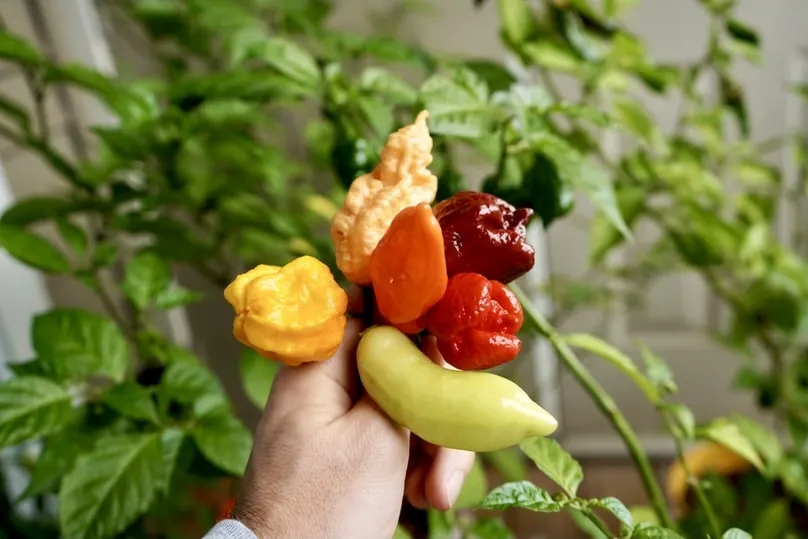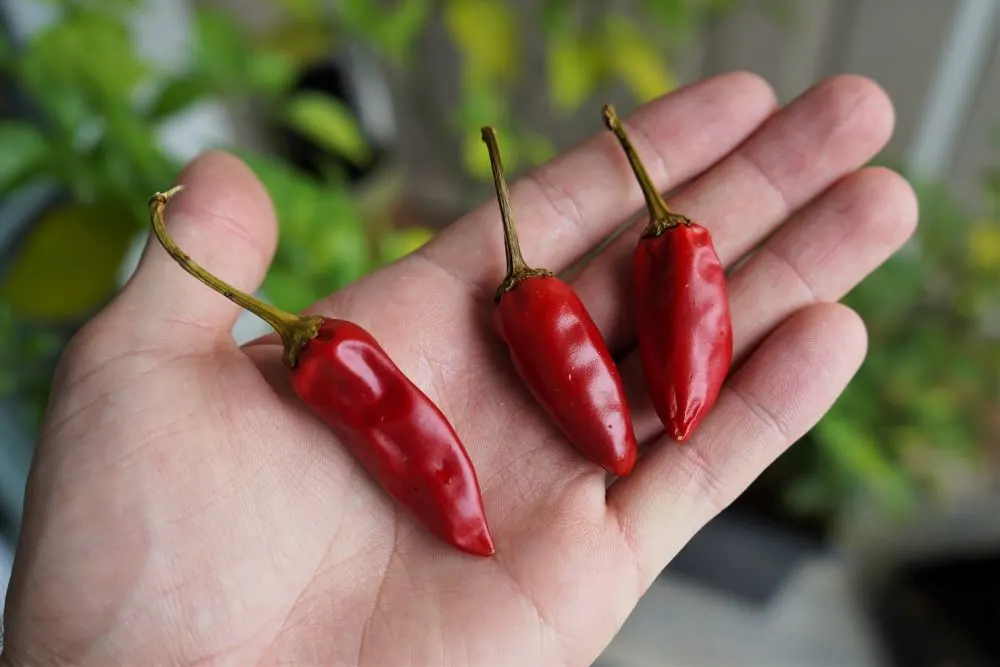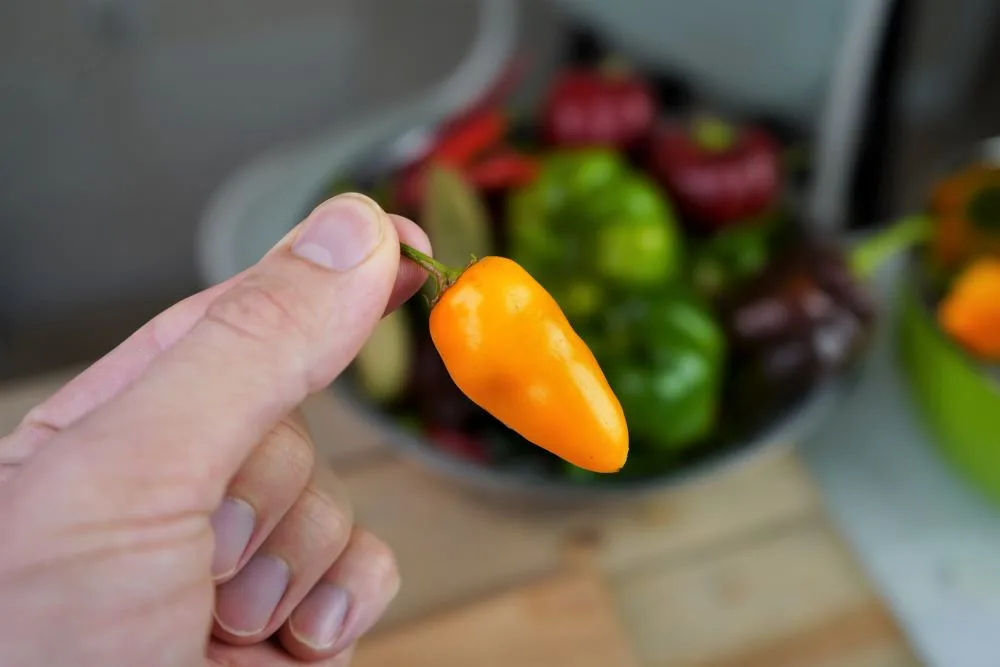Peppers are fascinating plants that are popular in gardens around the world. However, there is a subset of growers who only grow peppers, with a particular interest in the bizarre and exotic. There are 5 major domesticated pepper species, each of which has a whole host of unique varieties within.
In this article, we will cover some basic info about each major Capsicum species, along with some interesting facts.

Pepper Species Video:
Botanical Name for Peppers and Chiles
Let’s start with a broad overview of the botanical naming for peppers and chiles. Every plant is grouped within an order, family, genus and species.
Peppers, or chiles, are all part of the genus Capsicum. This genus is part of the wider family Solanaceae, the same family that contains tomatoes and eggplants.
Within the genus Capsicum, there are dozens of species, but only 5 have become domesticated. This means that the species has been cultivated by humans and refined over many generations. Let’s dive into each of the 5 major pepper species.
Capsicum Annuum
Capsicum Annuum Info:
- Origin: South America, many early varieties domesticated in Mexico (N. America)
- Pronunciation: AN-yoo-um
- Popular varieties: Bell, jalapeño, poblano, cayenne, Thai chili
Certainly the most well-known pepper species, Capsicum annuum is home to some of the most beloved varieties. These include the jalapeño, cayenne, bell, poblano, and so many more.
The heat levels of annuum peppers varies widely. Some have none at all, like bell peppers, and some are very spicy, like the assam and cayenne peppers. Size also ranges from enormous and thick walled to tiny, berry-like pods.
C. annuum is also home to many of the most gorgeous pepper plants and pods. The fish pepper plant has beautiful white and green variegated leaves and striped peppers.
The pimenta da neyde pepper is one of the most commonly cross-bred varieties thanks to its nearly black foliage and dark purple peppers.
Jalapeños are one of the most popular spicy peppers in the world, typically found in their unripe green color at grocery stores. Standard jalapeños will turn red when fully ripe, though some are unique colors, such as purple. NMSU even crossbred yellow, orange and brown varieties!
Capsicum Chinense
Capsicum Chinense Info:
- Origin: South and Central America
- Pronunciation: chi-NEN-see
- Name meaning: Of Chinese origin (though this is not actually true)
- Popular varieties: Habanero, scotch bonnet, ghost pepper, 7 pot peppers
Home to all of the hottest pepper varieties, Capsicum chinense is highly regarded in the pepper enthusiast world. Chinense peppers are typically pungent with powerful floral flavors. Many also have notes of citrus.
The immense variety of peppers in the chinense species continues to grow as it remains one of the most popular for cross breeding. The chinense species is known for having some of the ‘ugliest’ peppers, with wrinkled skin and long, stinger-like bottoms.
However, this is actually a good thing to many growers. The more strange a variety, the better. With high heat levels, wide variation in shape and size, and addictive flavor, it is no wonder that chinense remains the king of the capsicum species for many pepper geeks.
Capsicum Frutescens
The famous Tabasco Brand hot sauce uses a single pepper variety, and it comes from the frutescens species. These peppers are typically medium-spicy with thin walls and small pods. This makes tabasco peppers not the ideal choice for hot sauce, but it has become tradition.
Most frutescens pepper varieties have a bullet shape and ripen to red or orange. There are some types that will go through a variety of colors before reaching a final ripe coloration.
Flavor is generally uninspiring, though they make great peppers for cooking with heat. The pods will add plenty of spice to a dish without meddling with the intended flavors. Great for chili, stir fry and of course, hot sauce!
Capsicum Baccatum
Capsicum Baccatum Info:
- Origin: South and Central America
- Pronunciation: BACK-uh-tum
- Name meaning: Berry-like
- Popular varieties: Aji lemon drop, bishop’s crown
- Learn more about Capsicum baccatum here
Capsicum baccatum peppers come in a wide variety of shapes and heat levels. Some aji varieties are long and slender, while others take on more curled and bizarre shapes. Some notable examples: Brazilian starfish, bishop’s crown.
Breeders have only recently begun taking interest in the baccatum varieties. The recent sugar rush peach is a hit for its spicy pods and high yields. The even newer sugar rush striped pepper is gorgeous and rare!
Flavor ranges from super sweet and fruity to bitter and earthy. Some believe that the baccatum species is home to some of the tastiest peppers out there!
C. baccatum plants are often very tall and highly prolific. Recent cultivars are much larger than this species’ ancestors, resulting in pendulum-like hanging pods. Peppers often have long stems as well.
Capsicum Pubescens
Known for their ‘hairy’ foliage, Capsicum pubescens varieties are certainly the strangest domesticated pepper plants. Commonly known as the ‘tree pepper,’ ripe pods are thick walled and juicy.
The pubescens species is home to some of the only known cold-resistent pepper varieties. Some plants maintain a low and wide structure with small leaves while others can grow to be quite tall.
Heat varies, but some types can be quite spicy. The pepper shape is usually rotund, ranging from apple-like to more oblong. This makes them perfect for stuffing!
Fun fact: Capsicum pubescens seeds are jet black, and the plant’s flowers are purple.
Wild Pepper Species
While there are 5 domesticated species of pepper, there are at least 35 other species known to exist in the wild. Most of these species produce small berry-like fruits and are more challenging to grow.
Capsicum eximium is one example of a wild species, with likely origins in South America. This species produces purple flowers, like pubescens, indicating a relationship between the two species.
Capsicum galapagoense is another wild species found only in the Galápagos islands. The species is very rare and bizarre, with thick hairs (trichomes) on both the leaves and stems.
There are many, many more pepper species. Thankfully, the most exciting peppers to grow are easily accessible through seed sources online.
Cross Breeding Pepper Species
If you are interested in cross-breeding peppers, there are some things you should know. Firstly, peppers from the same species will cross most readily. This means that crossing two different chinense varieties will be more likely to succeed than crossing a chinense with a frutescens.
Secondly, the process takes a long time. You likely won’t see your first hybrid pepper variety for a year or longer.
Third, you will have highly unstable peppers for the first few generations. F2 seeds, or filial generation 2, are highly unstable. There is a tremendous amount of genetic variation in early generations. To reach a stable variety, at least 8 generations of selected, isolated plants must be grown!
If you are still interested in cross breeding, join the Facebook group Phenos & Crosses to learn and get inspired. The community loves to share amazing pictures from amateur and professional pepper breeders.
I hope this article about pepper species was helpful to you in some way! If there is anything missing, or something you believe should be added, let us know. Thanks for reading.







James Bier
Sunday 26th of November 2023
Love it!
Rick Bayless
Sunday 1st of January 2023
Calvin, I appreciate very much what you are doing to keep the chilihead community going. I am impressed by your knowledge and your publications. You must have studied at New Mexico.
Do you remember an old guy who went by "peppermeister"? He was an early chilihead who contributed tremendously to preserving rare varieties and to our knowledge and photo databases. He lived up north, Mass. or NH I believe, but managed to grow lots of peppers. He always responded to my email questions and sent me seeds I requested.
There was a second guy who came along going by "peppermeister" who lived in CA. He made many contributions also, very friendly, and was also good at responding and sharing.
There are so many others I could mention, the Canada woman who organized seed exchanges, Mike the recipe guy and others. I wish I could remember their names...
George Bessey
Wednesday 7th of December 2022
Thank yu Calvin , I am going to try a different variety of pepper along with the 3 standard ones this yr thanks to your video. George
coelacanth
Sunday 18th of September 2022
I enjoyed your video as well as some of your other content. I will return when I have more time. This year's gardening adventure involves the unintentional cross pollination of four different c. annuum species. Anaheims, poblanos, jalapenos and serranos were planted in containers in the back yard here in the central Arizona highlands. Strong winds and summer storms during the flowering phase and a fairly steady stream of pollinators ( hiney bees, ants and various hover flies ) seems to have resulted in all my fruits having significant capsaicin regardless the species. Anaheims and poblanos with jalapeno spiciness but a little residual sweetness are common. Jalapenos with serrano level intensity are as well. This is the first year of gardening here but clearly I have a lot to learn. Thanks for a good, informative site. c.
Joel
Saturday 30th of April 2022
Very neat article.
Thank you,
peppergeek
Saturday 30th of April 2022
So glad you found it and enjoyed!